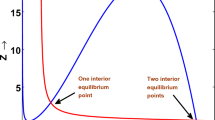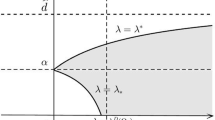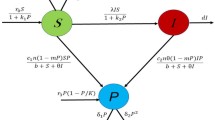Summary
A predator-prey system is proposed in which the prey species consists of three genotypes. It is shown that in the case of no predation, this system satisfies the Hardy-Weinberg principle. In the case where the genotype with the recessive gene has an advantage in its susceptibility to predation, it is shown that the other genotypes move toward extinction.
Similar content being viewed by others
References
Aronson, D. B., Weinberger, H. F.: Nonlinear diffusion in population genetics, combustion, and nerve propagation. Proceedings of the Tulane Program in Partial Differential Equations, Berlin, Heidelberg, New York: Springer 1975
Allen, P. M.: Darwinian evolution and a predator-prey ecology. Bull. Math. Biol.37, 389–405 (1975)
Bishop, J. A., Cook, L. M.: Moths, melanism and clean air. Sci. Amer.32, 90–99 (1975)
Clarke, B.: Mutation and population size. Heredity31, 367–379 (1973)
Charlesworth, B.: Selection in density-regulated populations. Ecology52, 469–475 (1971)
Freedman, H. I.: Graphical stability, enrichment, and pest control by a natural enemy. Math. Biosci.31, 207–225 (1976)
Freedman, H. I., Waltman, P. E.: Mathematical analysis of some three-species food-chain models. Math. Biosci.33, 257–276 (1977)
Haldane, S. B. S.: The mathematical theory of natural and artificial selection. Trans. Cambridge Philos. Soc.23, 19–41 (1924)
Holling, C. S.: Some characteristics of simple types of predation and parasitism. Canad. Entomol.91, 385–398 (1959)
Jacquard, A.: The Genetic Structure of Populations. Berlin, Heidelberg, New York: Springer 1974
Nemytskii, V. V., Stepanov, V. V.: Qualitative Theory of Differential Equations. Princeton: University Press 1960
Rosenzweig, M. L.: Evolution of the predator isocline. Evolution27, 84–94 (1973)
Rosenzweig, M. L., Macarthur, R. H.: Graphical representation and stability conditions of predator-prey interactions. Amer. Nat.47, 209–223 (1963)
Roughgarden, J.: Density dependent natural selection. Ecology52, 453–468 (1971)
Samuelson, P.: A universal cycle? Operations Research-verfahren3, 307–320 (1967)
Author information
Authors and Affiliations
Additional information
Research for this paper was partially supported by the National Research Council of Canada Grant NRC A-4823, and was carried out while this author was visiting The University of Iowa.
Rights and permissions
About this article
Cite this article
Freedman, H.I., Waltman, P. Predator influence on the growth of a population with three genotypes. J. Math. Biology 6, 367–374 (1978). https://doi.org/10.1007/BF02463001
Received:
Revised:
Issue Date:
DOI: https://doi.org/10.1007/BF02463001




